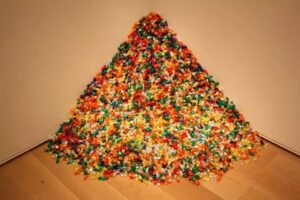After watching Derek Jarman’s “Blue”. I read about the film, and when the film was made, Drake was almost completely blind at the time. Blindness is a by-product of AIDS, and the blue on the image is exactly the color of his vision when he received retinal treatment.
I disagree with the term “sensory struggle”. It seems more appropriate to replace it than to say it is a struggle. Unlike the techniques and expressions of traditional films, there are no characters, no action, and no story in BLUE, only pure Blue, thought-provoking blue, plus monologues, plus all the background sounds, let people follow him into a state of meditation. While these voices were talking about the meaning of “blue” abstractly, they were amplifying all the beautiful thoughts in his mind.


Untitled is a famous “candy” artwork by artist Felix Gonzalez-Torres. He creates individual sensory engagement by creating stacks of fine paper-wrapped candies and encouraging viewers to pick up and eat the sweets. He hopes that people can discover the beauty of everyday life in it. The sheer amount of candy seemed to be Ross’s healthy weight. Every time the audience takes one piece of candy, it is like taking away the energy in Ross’s body, a metaphor for the life he lost due to AIDS.
- The two works “Untitled” and “Blue” have one thing in common. They use the human body’s senses of vision and touch to achieve multiple experiences of the work and to explore issues that have always existed in the public and private fields. Sometimes works of art do not necessarily solve a social problem, they can play a role in magnifying and exposing it.

